Developer Guide
- Getting Started
- Design and Architecture
- Implementation
- Appendix: Requirements
- Appendix: Instructions for manual testing
Getting Started
Refer to the guide Setting up and getting started.
Design
Architecture

The Architecture Diagram given above explains the high-level design of the App. Given below is a quick overview of each component.
Main has two classes
called Main
and MainApp. It
is responsible for,
- At app launch: Initializes the components in the correct sequence, and connects them up with each other.
- At shut down: Shuts down the components and invokes cleanup methods where necessary.
Commons represents a collection of classes used by multiple other components.
The rest of the App consists of four components.
-
UI: The UI of the App. -
Logic: The command executor. -
Model: Holds the data of the App in memory. -
Storage: Reads data from, and writes data to, the hard disk.
Each of the four components,
- defines its API in an
interfacewith the same name as the Component. - exposes its functionality using a concrete
{Component Name}Managerclass (which implements the corresponding APIinterfacementioned in the previous point.
How the architecture components interact with each other
The Sequence Diagram below shows how the components interact with each other for the scenario where the user
issues the command cdelete 1.

The sections below give more details of each component.
UI Component

API :
Ui.java
The UI consists of a MainWindow that is made up of parts e.g.CommandBox, ResultDisplay, ContactListPanel
, StatusBarFooter etc. All these, including the MainWindow, inherit from the abstract UiPart class.
The UI component uses JavaFx UI framework. The layout of these UI parts are defined in matching .fxml files that are
in the src/main/resources/view folder. For example, the layout of
the MainWindow
is specified
in MainWindow.fxml
The UI component,
- Executes user commands using the
Logiccomponent. - Listens for changes to
Modeldata so that the UI can be updated with the modified data.
Logic component

API :
Logic.java
-
Logicuses theTeachingAssistantParserclass to parse the user command. - This results in a
Commandobject which is executed by theLogicManager. - The command execution can affect the
Model(e.g. adding a person). - The result of the command execution is encapsulated as a
CommandResultobject which is passed back to theUi. - In addition, the
CommandResultobject can also instruct theUito perform certain actions, such as displaying help to the user.
Given below is the Sequence Diagram for interactions within the Logic component for the execute("cdelete 1") API
call.

Model component

**
API** : Model.java
The Model,
- stores a
UserPrefobject that represents the user’s preferences. - stores Teaching Assistant data.
- exposes an unmodifiable
ObservableList<Contact>andObservableList<Entry>that can be ‘observed’ e.g. the UI can be bound to this list so that the UI automatically updates when the data in the list change. - does not depend on any of the other components.
Storage component

**
API** : Storage.java
The Storage component,
- can save
UserPrefobjects in json format and read it back. - can save Teaching Assistant data in json format and read it back.
Common Classes
Classes used by multiple components are in the seedu.ta.commons package.
Implementation
This section describes some noteworthy details on how certain features are implemented.
Deleting a contact in the address book
The command immediately responsible for this is the ‘DeleteContactCommand’
An outline of the implementation is as follows:
The TeachingAssistantParser should accept the command word cdelete. It will then get
the DeleteContactCommandParser
to parse and return the DeleteContactCommand. Subsequently, it returns CommandResult which is shown on the command
result field of the GUI as the information of the user that is deleted.
The following activity diagram summarizes what happens when a user executes the cdelete command:

The following sequence diagram summarizes what happens when a user executes the cdelete command:
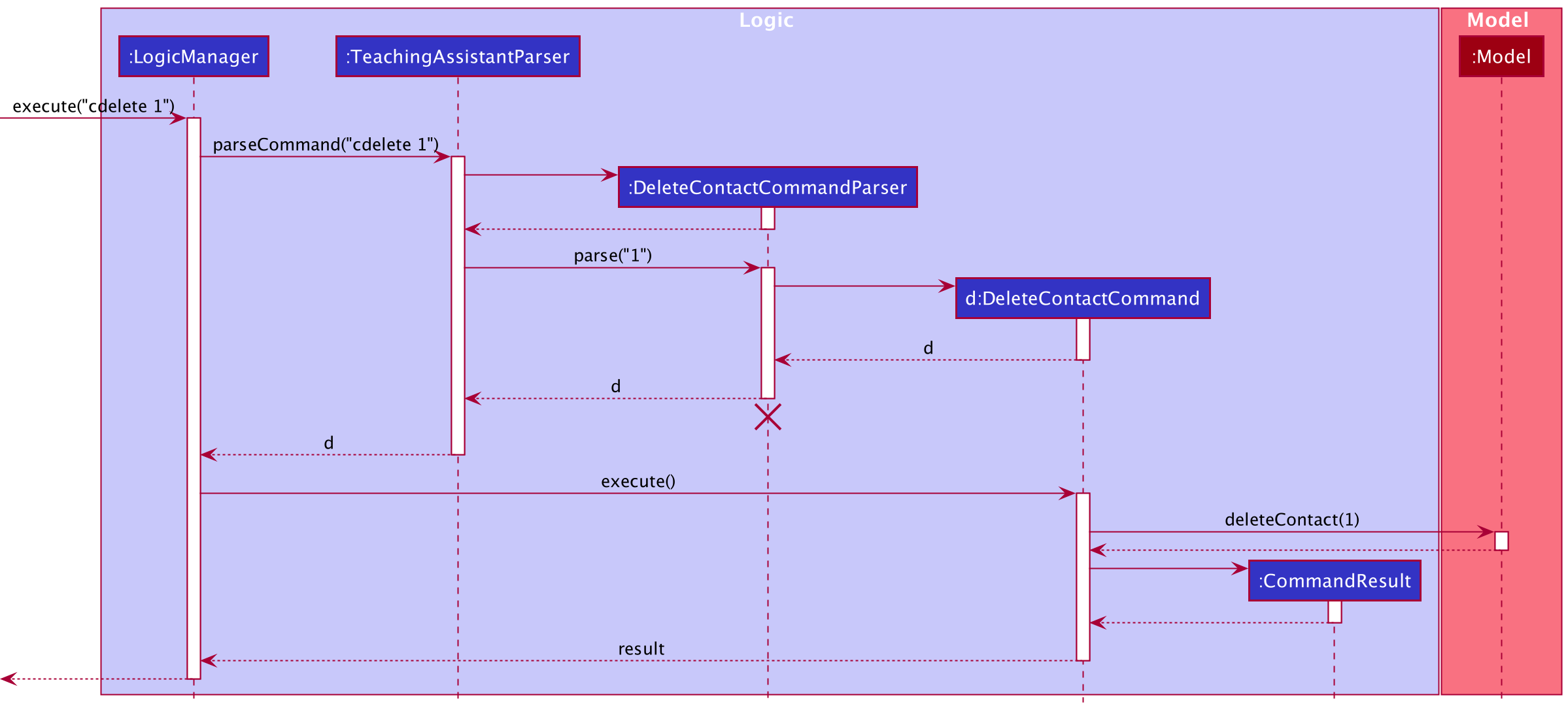
Enquire if time interval is free
The free command mechanism provides users a quick way to find out if certain time intervals are available.
An outline of the proposed implementation is as follows:
The TeachingAssistantParser should accept another case of command word free which eventually returns FreeCommand
back to Logic Manager.
This command is then executed to return CommandResult which is either shown on the result display of the GUI as:
- “You’re free!”
- Or “Sorry, you’re not free. Entries occupying that time interval listed below!”. The occupying entries are shown in the entry list at the main window.
The following activity diagram summarizes what happens when a user executes the new command:
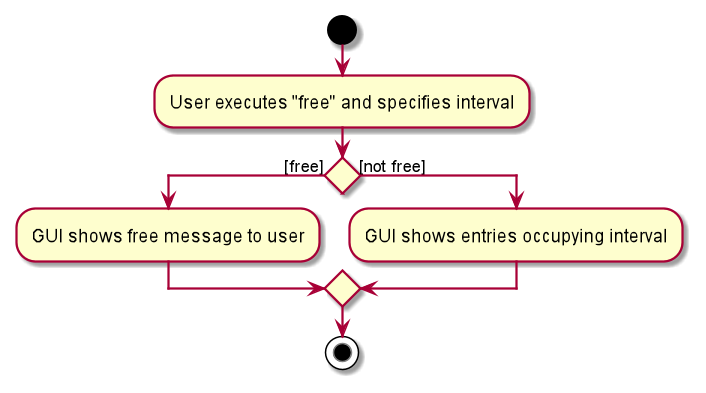
The implementation of this command is similar to the List Command but requires a new predicate class to be created.
A ListOccupyingEntryPredicate class is implemented that provides a predicate that accepts user provided start and end
interval. The predicate is provided to ModelManager#updateFilteredEntryList and updates the entry list according to
the condition under ListOccupyingEntryPredicate#test.
The following sequence diagram outlines how the free operation works:
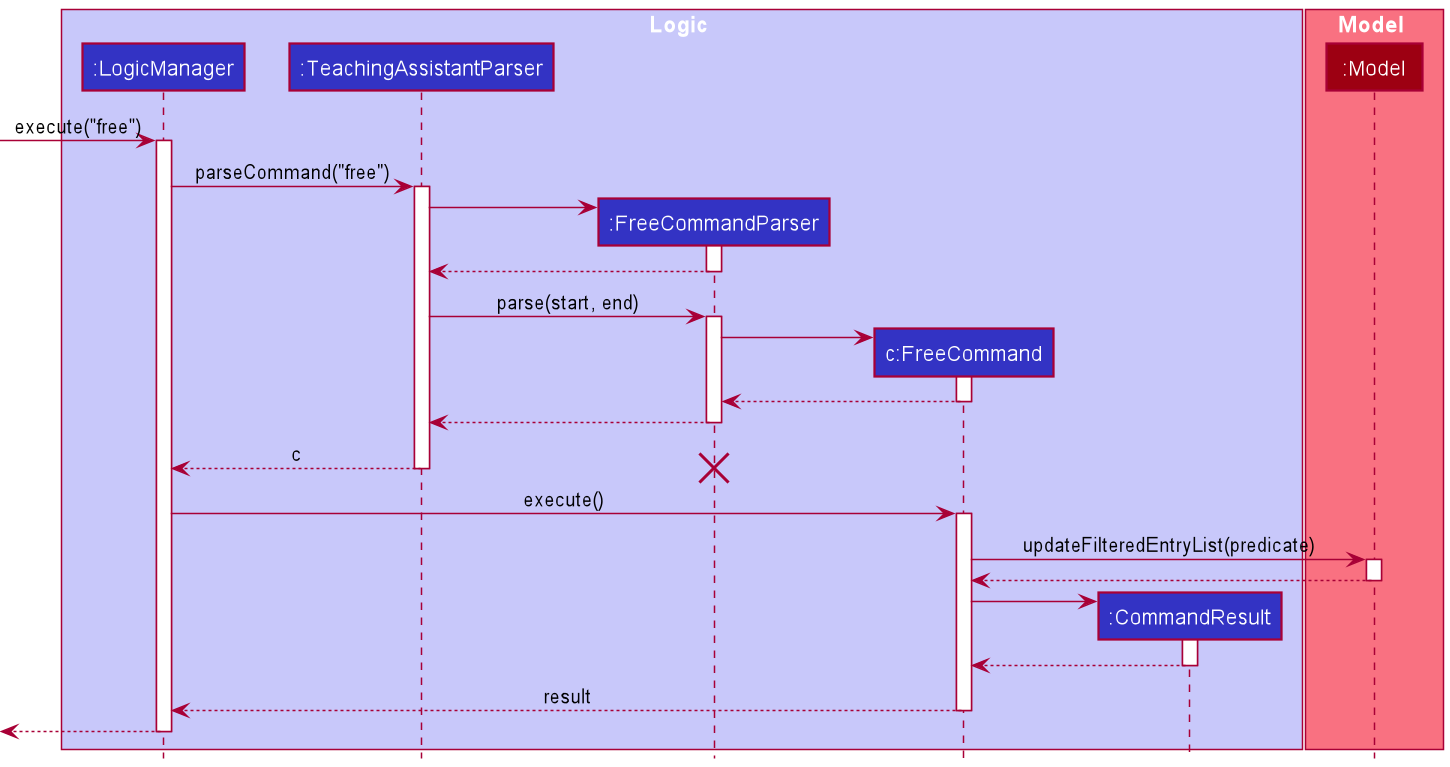
ListOccupyingEntryPredicate
has been omitted for simplicity.
Merge Schedule and Task
The merger attempts to combine the functionalities of both the Task and Schedule classes.
As the Task and Schedule classes are similar in features, we can merge them into an Entry class for maintainability.
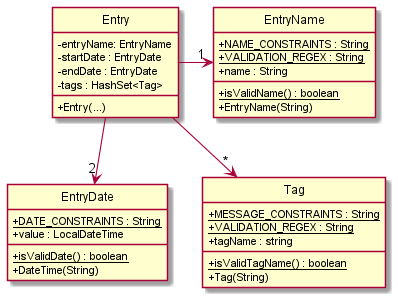
Previously, we allowed schedules and tasks to be added separately through using two commands, sadd and tadd.
Combining them into an Entry task, we implement an “eadd” command.
Below, we can see the before and after activity diagrams involving this merger.
Before:

After:
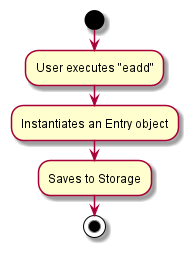
Filtering entries via tags
Following the proposal above, there were no commands that utilise the tags attached to the objects. Hence, this proposal aims to allow filtering these entries via their tags.
The Model class will be required to implement the updateFilteredEntryList which can incorporate
updateFilteredTaskList or updateFilteredScheduleList implemented in the previous two classes. This method will then
accept an argument of type EntryTagContainsKeywordsPredicate.
The following diagram omits the parser object created, namely FilterEntryCommandParser for simplicity.
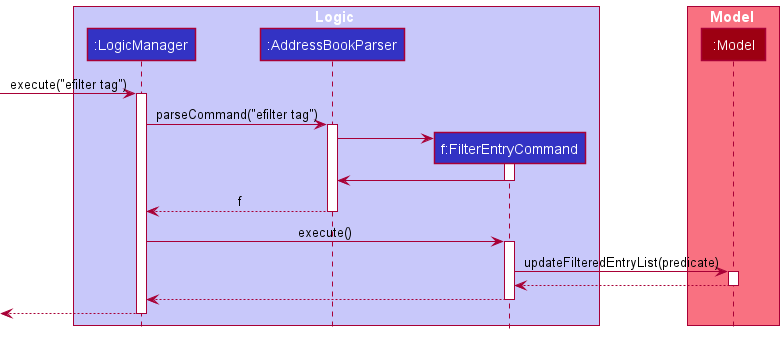
Design consideration
- Allow filtering by more than one tag.
- Decide whether the filtering above considers Union or Intersection of tags.
List entry feature
The list entry mechanism allows users to see all of their entries, or see them by day or by week.
An outline of the proposed implementation is as follows:
The TeachingAssistantParser should accept command word elist and eventually return a ListEntryCommand
back to LogicManager. This command can take in one of these three arguments: an empty string, the string “day” or the
string “week”. The arguments will be parsed by the ListEntryCommandParser to determine the behaviour of
ListEntryFormatPredicate. Then, updateFilteredEntryList method in the Model interface is called, passing in the
ListEntryFormatPredicate as an argument.
The following activity diagram (Fig 2.3.1) summarizes what happens when a user executes the list entry command.
 Fig 2.3.1
Fig 2.3.1
The following sequence diagram (Fig 2.3.2) shows how the list entry operation works:
 Fig 2.3.2
Fig 2.3.2
Clear overdue entry feature
Clear overdue entry feature allows users to quickly discard entries that are no longer relevant. i.e. entries with end dates that have passed.
An outline of the implementation is as follows:
The TeachingAssistantParser should accept another case of command word eclear which eventually returns a
ClearOverdueEntryCommand back to LogicManager. This command has no arguments and will immediately call
clearOverdueEntries method in Model interface. Finally, a new CommandResult is created to handle the result of
this command.
The following sequence diagram (Fig 2.3.3) shows how clear overdue entry command works:

Fig 2.3.3
The following activity diagram (Fig 2.3.4) shows how Model executes clearOverdueEntries:
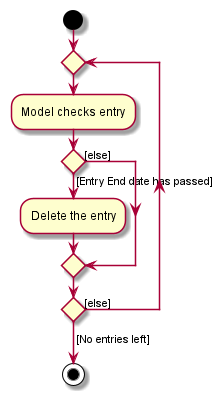
Documentation, logging, testing, configuration, dev-ops
Appendix: Requirements
Product Scope
Target user profile:
- Are JC/Secondary school teachers
- Do not have their schedules and students’ contacts digitalised
- Prefer to use typing over mouse/voice commands
Value proposition: efficient tool to keep track of schedules (i.e. entries) as well as find and add student contact information easily
User Stories
Contacts
| Priority | As a… | I want to… | So that I can… |
|---|---|---|---|
| high | teacher | add a contact | have a consolidated list of contacts that I require |
| high | teacher | delete a contact | remove a contact I no longer need |
| medium | teacher | edit a contact | modify contact details without going through the tedious process of removing and re-adding the contact |
| high | teacher | find a contact based on name | quickly find the details of a specific contact I need |
| high | teacher | list all contacts | keep track of the contacts of all the people I have saved |
| medium | teacher | filter contacts via tags | categorise and find a group of contacts easily |
Entries
| Priority | As a… | I want to… | So that I can… |
|---|---|---|---|
| high | teacher | add an entry | have a consolidated list of entries representing my schedule |
| high | teacher | delete an entry | remove entries that have been cancelled |
| medium | teacher | edit an entry | modify entry details without going through the tedious process of removing and re-adding the entry; in case an entry has been rescheduled |
| high | teacher | list my entries according to day/week | view my entries in a more organised way |
| high | teacher | find an entry based on name | see the details of an entry I have saved |
| low | teacher | view all entries in my schedule for a specific time period | check if I am free during that timing |
| medium | teacher | filter entries via tags | categorise and find entries easily |
| medium | teacher | clear all entries that have passed | easily see ongoing or future entries without past entries cluttering the list |
Others
| Priority | As a… | I want to… | So that I can… |
|---|---|---|---|
| high | forgetful teacher | be prompted for the User Guide | refer to it and type all commands without memorising their syntax |
| low | first time user | clear all my contacts and entries from teaching assistant | clear all sample data easily |
Use Cases
(For all use cases below, the System is the Teaching Assistant and the Actor is the user, unless specified
otherwise)
Use case: UC01 - Add a contact
MSS
- User requests to add a contact
-
Teaching Assistant adds the contact into the list
Use case ends.
Extensions
-
2a. The given field(s) are invalid.
-
2a1. Teaching Assistant shows an error message
Use case ends.
-
-
2b. The contact to be added already exists in Teaching Assistant.
-
2b1. Teaching Assistant shows an error message.
Use case ends.
-
Use case: UC02 - Delete an Entry
MSS
- User requests to list entries (UC03)
- Teaching Assistant shows a list of entries
- User requests to delete a specific entry in the list
-
Teaching Assistant deletes the specified entry
Use case ends.
Extensions
-
2a. The list of entries is empty.
Use case ends.
-
3a. The given index is invalid
-
3a1. Teaching Assistant shows an error message.
Use case ends.
-
Use case: UC03 - List entries
MSS
- User requests to list entries.
-
Teaching Assistant shows a list of entries.
Use case ends.
Extensions
-
1a. User requests to list entries that occurs today.
-
1a1. Teaching Assistant shows a list of entries that happen today.
Use case ends.
-
-
1b. User requests to list entries that occurs this week.
-
1b1. Teaching Assistant shows a list of entries that occurs this week
Use case ends.
-
-
1c. The given parameter is invalid.
-
1c1. Teaching Assistant shows an error message.
Use case ends.
-
Use case: UC04 - Check if user is free on a given timeslot
MSS
- User requests to if he/she is free on a given timeslot.
-
Teaching Assistant replies that the user is free.
Use case ends.
-
1a. The given timeslot is invalid.
-
1a1. Teaching Assistant shows an error message.
Use case ends
-
-
1b. The user is not free on the given timeslot.
-
1b1. Teaching Assistant replies that the user is not free.
-
1b2. Teaching Assistant shows a list of entries that coincide with the given timeslot.
Use case ends
-
Use case: UC05 - Find a contact
MSS
- User requests to find a contact with specified keyword(s)
-
Teaching Assistant replies to the user contacts that matches the keyword(s)
Use case ends.
-
1a. The given keyword(s) are invalid
-
1a1. Teaching Assistant shows an error message.
Use case ends
-
-
2a. No contact matches the specified keyword(s).
-
2a1. Teaching Assistant shows an empty list.
Use case ends
-
Non-Functional Requirements
- Should work on any mainstream OS as long as it has Java 11 or above installed.
- A user with above average typing speed for regular English text (i.e. not code, not system admin commands) should be able to accomplish most of the tasks faster using commands than using the mouse.
- The system should be usable by a novice who has never used virtual management applications.
- The user interface should be intuitive enough for users who are not IT-savvy.
- The product is offered as an open source software.
Glossary
JC
Junior College (JC) is the post-secondary education level where students are preparing for university. JC is also the high-school equivalent in other countries. Hence, JC teachers may be packed with consultation schedules which can leverage our software.
Mainstream OS
Mainstream operating systems are the current operating systems with a significant market share, namely Windows, Linux, Unix, and OS-X.
MSS
Main Success Scenario (MSS) defines the optimal outcome of our commands, i.e. in the case where no errors occurred.
Appendix: Instructions for manual testing
Adding an entry
- Adding an entry while all entries are being shown.
- Prerequisites: The entry should not already exist in the entry list and the new entry’s start and end datetime
should not overlap with existing entries. List all entries using the
elistcommand. - Test case:
eadd n/Meeting sd/2021-12-12 13:00 ed/2021-12-12 14:00
Expected: The entry is added to the entry list. Success message with details of the added entry is shown in the result window. - Test case:
eadd n/Meeting sd/2021-12-12 19:00 ed/2021-12-12 13:00
Expected: The entry is not added. Error message is shown in the result display indicating that start datetime has to be before end datetime.
- Prerequisites: The entry should not already exist in the entry list and the new entry’s start and end datetime
should not overlap with existing entries. List all entries using the
Finding an entry
- Finding an entry while all entries are being shown.
- Prerequisites: There should be entries present in the entry list. List all entries using the
elistcommand. - Test case:
efind Meeting
Expected: Assuming that there is an entry named “Meeting”, a message indicating how many entries are listed is shown in the result window. Entry list will only list the entry with the matching name. - Test case:
efind Random
Expected: Assuming that there are no entries named Random, a message shown in the result display will indicate 0 entries being listed. Entry list will be empty.
- Prerequisites: There should be entries present in the entry list. List all entries using the
Filtering tags
- Filtering tags while all entries are being shown.
- Prerequisites: There should be entries with tags present. List all entries using the
elistcommand. - Test case:
efilter consultation
Expected: Assuming there is only one entry that has the tagconsultation, a message is shown in the result display indicating 1 entry is being listed. Entry list will only list the entry with the matching tag. - Test case:
efilter CCA Tennis
Expected: Assuming there is only one entry that has both tagsCCAandTennis, a message is shown in the result display indicating 1 entry is being listed. Entry list will only list the entry with the matching tags.
- Prerequisites: There should be entries with tags present. List all entries using the
Editing an entry
- Editing an existing entry while all entries are being shown.
- Prerequisites: There should be entries present in the entry list. List all entries using the
elistcommand. - Test case:
eedit 1 p/97865534
Expected: The entry that is numbered “1.” is edited such that the previous phone number is now changed to the new one specified. Details of the edited entry is shown in the result display. - Test case:
eedit 1
Expected: No entry is edited. Error details shown in the result display indicating at least one field should be given.
- Prerequisites: There should be entries present in the entry list. List all entries using the
Listing entries
- Listing entries while there are entries present and are not currently all listed.
- Prerequisites: There should be entries present in the entry list but not all of them are seen.
- Test case:
elist
Expected: Success message indicating how many entries are listed is shown in the result display. All entries that are present are shown in the entry list. - Test case:
elist day
Expected: A message indicating how many entries are listed is shown in the result display. All entries that have the same date as the current date are shown in the entry list. - Test case:
elist week
Expected: A message indicating how many entries are listed is shown in the result display. All entries that have date 6 days from the current date or same date as current date are shown in the entry list.
Checking if interval is free
- Checking if an interval is free while there are entries present.
- Prerequisites: There should be entries present in the entry list. The start and end datetime field provided should fall within the datetime of at least one entry to test the “Not free” response.
- Test case:
free sd/2021-12-12 13:00 ed/2021-12-12 14:00
Expected: Assuming there is only one entry that falls within this interval, message indicating the interval is not free is shown in the result display. Entry list will only list the entry that occupies the interval. - Test case:
free sd/2021-11-13 13:00 ed/2021-11-13 14:00
Expected: Assuming there are no entries that falls within this interval, message indicating the interval is free is shown in the result display. Entry list will be empty.
Deleting entries
- Deleting an entry while all entries are being shown.
- Prerequisites: List all entries using the
elistcommand. Multiple entries in the list. - Test case:
edelete 0
Expected: No entry is deleted. Error details shown in the result display. Entry list remains the same. - Test case:
edelete 1
Expected: The entry that is numbered “1.” is deleted from the entry list. Details of the deleted entry is shown in the result display.
- Prerequisites: List all entries using the
Clearing overdue entries
- Clearing overdue entries while there are overdue entries present.
- Prerequisites: There should be overdue entries (shown as a red entry box) in the entry list.
- Test case:
eclear
Expected: Success message is shown. All entries that are before current date and time should be deleted.
Adding a contact
- Adding a contact while all contacts are being shown.
- Prerequisites: The contact should not already exist in the list. List all contacts using the
clistcommand. - Test case:
cadd n/Danny Tan p/98765432 e/danny@email.com
Expected: The contact is added into the contact list. Success message with details of the added contact is shown in the result window. - Doing the exact same command one more time will fail with an error message as duplicated contacts are not allowed to be added into the list
- Prerequisites: The contact should not already exist in the list. List all contacts using the
Finding contacts
- Finding contacts while all contacts are being shown
- Prerequisites: There should be at least a contact present in the contact list. List all contacts using the
clistcommand. - Test case:
cfind Danny
Expected: Assuming that there is at least a contact named “Danny”, a message indicating how many contacts are listed is shown in the result window. Contact list will only list the contacts with the matching name. - Test case:
cfind Random
Expected: Assuming that there are no contacts named “Random”, a message shown in the result display will indicate 0 contacts being listed. Contact list will be empty.
- Prerequisites: There should be at least a contact present in the contact list. List all contacts using the
Filtering contacts via tags
- Filtering tags while all contacts are being shown.
- Prerequisites: There should be contacts with tags present. List all contacts using the
clistcommand. - Test case:
cfilter friend
Expected: Assuming there is only one contact that has the tagfriend, a message is shown in the result display indicating 1 contact is being listed. Contact list will only list the contact with the matching tag. - Test case:
cfilter family important
Expected: Assuming there is only one contact that has both the tagsfamilyandimportant, a message is shown in the result display indicating 1 contact is being listed. Contact list will only list the contact with the matching tags.
- Prerequisites: There should be contacts with tags present. List all contacts using the
Editing a contact
- Editing an existing contact while all contacts are being shown.
- Prerequisites: There should be contacts present in the contact list. List all contacts using the
clistcommand. - Test case:
cedit 1 n/Amy Toh
Expected: The contact that is numbered “1.” is edited such that the previous name is now changed to the new one specified. Details of the edited contact is shown in the result display. - Test case:
cedit 1 n/Amy Toh p/98761234
Expected: The contact that is numbered “1.” is edited such that the previous name and phone number are now changed to the new ones specified. Details of the edited contact is shown in the result display. - Test case:
cedit 1
Expected: No contact will be edited. Error details shown in the result display indicating at least one field should be given.
- Prerequisites: There should be contacts present in the contact list. List all contacts using the
Deleting a contact
- Deleting a contact while all contacts are being shown.
- Prerequisites: List all contacts using the
clistcommand. Contact list must not be empty. - Test case:
cdelete 0
Expected: No contact is deleted. Error details regarding the invalid argument will be shown in the result display. Contact list remains the same. - Test case:
cdelete 1
Expected: The contact that is numbered “1.” is deleted from the contact list. Details of the deleted contact is shown in the result display.
- Prerequisites: List all contacts using the